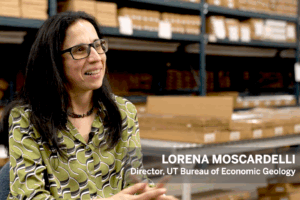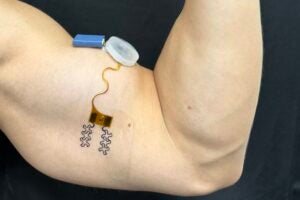AUSTIN, Texas—New efforts to find evidence of water on the moon came up dry, researchers at The University of Texas at Austin announced Wednesday (Oct. 13). But their research efforts have laid the groundwork for further investigations, as well as demonstrating a potentially useful new method for lunar prospecting.
The UT Austin group announced its findings at the annual meeting of the American Astronomical Society’s Division for Planetary Sciences in Padua, Italy. In what was virtually a no-budget attempt to vaporize ice suspected to exist at the South Pole of the moon, NASA worked with engineers and astronomers at UT Austin to crash the space agency’s successful Lunar Prospector spacecraft in a specific polar crater in a precise manner.
The July 31 crash took only seconds. But the painstaking analysis of information recorded by more than a dozen professional Earth- and space-based telescopes required several months. Hundreds of amateur telescope owners also observed as the spacecraft plunged into a permanently shadowed crater near the pole.
“As expected, we didn’t make a big splash, or we all would have seen a water signal quickly,” said Dr. David Goldstein, leader of the UT Austin team that proposed the crash. Goldstein, an aerospace engineer, is an associate professor in the UT Austin Department of Aerospace Engineering and Engineering Mechanics.
Prior to the crash, Goldstein worked to model and calculate the final orbit and crash of the Lunar Prospector with Dr. R. Steven Nerem, also an aerospace engineer and an associate professor in the department; aerospace engineering students J. Victor Austin and Jeong Yon Shim; and NASA engineers. Dr. Edwin S. Barker, research scientist with the UT Austin Department of Astronomy, coordinated worldwide observations of the crash.
Last year, the Lunar Prospector team reported the spacecraft’s instruments had revealed possible signs of frozen water at the moon’s north and south poles. At that point, the UT Austin team came up with the idea of a controlled crash.
“The way we aimed to detect water — or its signature — was through sensitive spectrometers tuned to look for the ultraviolet spectral emission lines expected from the hydroxyl (OH) molecules,” said Barker. Barker and Shim analyzed the spectra from NASA’s Hubble Space Telescope, McDonald telescope and the Keck I in Hawaii.
Scientists and engineers working on the project knew from the beginning that there was a low probability of proving existence of water on the moon and the research discussed in Padua did not confirm water’s existence. But the researchers said several benefits resulted from this potentially high-payoff experiment, including
- Development of a coordinated observation program among many observers working together throughout the world, including more than a dozen professional teams of astronomers;
- Establishment of useful upper limits on estimates of the density of the Moon’s thin natural atmosphere; and
- Establishment of a possible means of lunar prospecting using direct impacts.
“If we can identify any other spacecraft whose useful life is over, but may have sufficient fuel and controllability to repeat the impact experiment, we’d like to do it again,” said Goldstein.
The team offered several possible reasons why the telescopic information has yielded no evidence of water, however, there is no way of knowing which of them might apply:
- The spacecraft might have missed the target;
- The spacecraft might have hit a rock or dry soil at the target site;
- Water molecules may be firmly bound in rocks as hydrated minerals, rather than existing as free ice crystals, and the crash lacked enough energy to separate water from hydrated minerals;
- No water exists in the crater and the hydrogen detected earlier by the Lunar Prospector spacecraft was simply pure hydrogen;
- Pre-impact studies were inadequate;
- Parameters used in modeling the vapor gas dynamics were inadequate;
- The telescopes, which have a very small field of view, may not have been pointed correctly;
- Water and other materials may not have risen above the crater wall or otherwise may have jetted away from the telescopes’ view.
For additional information, contact Dr. R. Steven Nerem (512) 471-7599, Douglas Isbell at NASA Headquarters, Washington, D.C. (202) 358-1547 or the UT Austin Office of Public Affairs, (512) 471-3151. The other UT principal investigators also may be contacted after certain dates: David B. Goldstein (512) 471-4187 (after Oct. 22) and Edwin S. Barker (512) 471-3432 (after Oct. 23).
See also NASA TV video file at GE-2, transponder 9C at 85 degrees West longitude, with vertical polarization. Frequency is 3880.0 megahertz, with audio at 6.8 megahertz. Video files are available 12, 3, 6, and 9 p.m. eastern time. For video questions, call NASA at (202) 358-4555 or (202) 358-1696.
For a more detailed discussion and history of the project, plus illustrations (including target site, expected evolution of vapor cloud and animations) see the new posting embargoed for Oct. 13 at: http://www.ae.utexas.edu/~cfpl/lunar/pressrelease



